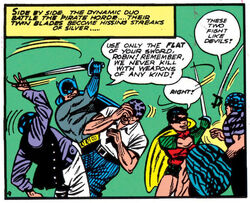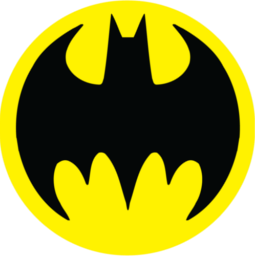(→Films) |
(Adding categories) |
||
| Line 67: | Line 67: | ||
<references/> |
<references/> |
||
__NOTOC__ |
__NOTOC__ |
||
| + | [[Category:Miscellaneous]] |
||
Revision as of 16:36, 26 September 2020
In most continuities, Batman retains a set of rules around how far he should go. These often are done to either keep within the lines of the law or stop him from going beyond redemption. Over the years, they have generally become simplified to either No Killing or No Firearms rules. However, some incarnations, including the mainline Batmen, have either broken or not retained these.
History
Golden Age
When first introduced, Batman did not have any concern about the lives of his enemies. His first confirmed kill was in Detective Comics #27, where he knocked Alfred Stryker into a vat of acid. Batman continued to murder criminals or leave them to die. In some stories, he also wielded a pistol. Both Bill Finger and Bob Kane mentioned this was due to the influence of pulp action heroes in comics, such as The Shadow and Green Hornet. Both were well known for wielding firearms and often used lethal methods to dispatch enemies.
This continued until Batman #1, where he gunned down Hugo Strange's henchmen and hung one of the Monster Men with a noose from the Batgyro. According to Bob Kane, this incident evoked complaints from parents, due to children becoming interested following the introduction of Robin. This led editor Whitney Ellsworth to tell Finger to never have him use guns again. The editor later created a policy for all published characters from killing, which stated "Heroes should never kill a villain, no matter the depths of his villainy."

The debut of Batman's "rules"
Officially, Batman's "no killing" rule came into affect in Batman #4. During a swordfight with pirates, Batman tells Robin "Use only the flat of your sword, Robin! Remember, we never kill with weapons of any kind!"[1] Furthermore, the character's now working association with the Gotham City Police Department and meant he would have to work within the guidelines of the law, meaning he could not violate these.
Despite these changes, Batman still continued to kill criminals in his stories, though most were indirectly caused by either knocking them into hazards or throwing them off buildings. However, direct kills were gradually phased out, though they still continued to occur albeit rarely.
Batman's killing sprees finally stopped after a trip to the frontlines of World War II during Batman #15. This issue was notably one of the largest sprees in his history, causing a vehicle crash and later destroyed an entire warship full of soldiers. After this incident and with the new policies in place, Batman would not kill his enemies or attempt to prevent their deaths. Some stories would justify this as him attempting to allow justice to be served.
Silver Age
Due to Fredric Wertham's Seduction of the Innocent targeting comics for violent acts and blaming them for juevinial delinqency, the Comics Magazine Association of America by the Comics Code Authority's guidelines to prevent government intervention. This meant that acts of violence, including those perpetuated by supervillains, could not be written or shown.
Some of these guidelines included:
- Scenes of excessive violence shall be prohibited. Scenes of brutal torture, excessive and unnecessary knife and gunplay, physical agony, the gory and gruesome crime shall be eliminated.
- Inclusion of stories dealing with evil shall be used or shall be published only where the intent is to illustrate a moral issue and in no case shall evil be presented alluringly, nor so as to injure the sensibilities of the reader.
These meant that Batman could no longer be portrayed as a vigilante operating on the edge or use excessive violence, though these rules had been in place since 1940. This also meant that Batman and Robin could not get into fights nor use direct violence on their enemies. The new portrayal of the characters would later influence the 1960s Batman series.
Bronze Age
| This section is a stub. You can help the Batman wiki by expanding it. |
Modern Age
| This section is a stub. You can help the Batman wiki by expanding it. |
Other Versions
| This section is a stub. You can help the Batman wiki by expanding it. |
In Other Media
Television
| This section is a stub. You can help the Batman wiki by expanding it. |
Films
Batman Film Anthology
In the Batman Film Anthology, Batman initially does not adhere to the "No Killing" rules, though abides by them in later entries.
In Batman, it is implied that the Dark Knight murdered small-time criminal Johnny Gobs prior to its events. Later, he uses the Batmobile to plant explosive devices within the Axis Chemicals building, which apparently detonate next to a group of Joker's henchmen. It can also be assumed that others, including possible bystanders, could have died in the resulting explosions. Batman later guns down some henchmen in the Batwing and, during the confrontation at the Old Gotham Cathedral, throws one of them down the building's staircase without any support or safe landings. He later causes the Joker's death by tying a loose gargoyle to his leg during his escape attempt, ultimately causing him to fall from his helicopter. Additionally, in a cut moment from drafts and the shooting script for the alleyway fight, Batman used one of the henchmen as a human shield against his friends' gunshots.
In Batman Returns, Batman uses the Batmobile's afterburner to ignite a Firebreather. It's ambiguous whether they died from their injuries or survived, albiet badly burned. Later, he attaches a bomb to the Tattooed Strongman and knocks him unconscious, letting the bomb detonate. In the fight with the Penguin, Batman releases a flock of bats from the Batskiboat and, having tricked him into stealing an Ultrasonic Bat Beacon, allow them to attack him. This causes the criminal to fall into toxin waste below and poison him, though he may have been unaware of it. However, Batman insists on arresting Max Shreck rather than let Catwoman kill him, though why is never properly addressed.
In Batman Forever, Batman does not directly kill any criminals or henchmen. In dialogue shared with Dick Grayson, he implies that he has adopted it to prevent him from falling down a darker path, likely due to what happened to Selina. However, during the final confrontation with Two-Face, he throws multiple coins during at the criminal, causing him to lose track his own. Dent subsequently loses balance and falls to his death; Batman not attempting to save him. In addition, he also indirectly causes multiple explosive crashes whilst chased by Two-Face's Thugs, though these were possibly unintended.
In Batman & Robin, Batman does not attempt to kill or cause the death of any characters or henchmen. This likely means he has officially adopted codes against killing after allowing Grayson to help him as Robin. Despite this, the two comment about having to kill Barbara after she learns their identities. However, this is likely a joke referencing how most villains in their previous adventures die after learning their identities.
The Dark Knight Trilogy
In The Dark Knight Trilogy, Batman adheres to a strictly to no-lethal tactics. However, the character occasions breaks these and causes indirect on several occasions. In Batman Begins, he comments that he avoids killing to avoid become like the criminals he faces, believing that doing so will make him like his enemies. In The Dark Knight Rises, he also comments to refuse to use firearms or guns, knocking one out of the hands of Selina Kyle before she can shoot one of John Daggett's men.
Despite this, Batman does cause multiple deaths during the films. While escaping the League of Shadows in Batman Begins, Bruce knocks a poker over and lights a fire. This causes several explosions, killing some of its members, and structural collapse, which kills the decoy Ra's al Ghul. Batman also causes one of Jonathan Crane's henchmen into shooting another's foot, though this injury is non-fatal. In the final fight with the true Ra's, he chooses to abandon him rather than rescue or actually murder him. Many have interpreted this as Batman choosing to kill his mentor as opposed to leaving his fate out of his hands.
Batman retains the rules during The Dark Knight, not using any weapons or firearms in fights and avoids indirect kills. He also refuses to kill the Joker on multiple occasions and even saves him from a lethal fall during their final confrontation. Despite these, he does cause several deaths. Notably, he crashes the Tumbler into a garbage truck driven by Joker's thugs whilst protecting Harvey Dent, causing the driver's front to be crushed between it and the tunnel's ceiling. He also later tackles Dent off a ledge to save Gordon's son, causing the district attorney to fall to his death.
Despite the clear murder of Dent in the latter, Batman continues to abide by the No-Killing and No Firearms rules. Despite this, he uses the Bat's cannons to destroy one of Bane's Tumblers and later at Talia al Ghul and an unnamed driver, killing the former. This also causes Talia to crash, causing fatal injuries.
DC Extended Universe
| This section is a stub. You can help the Batman wiki by expanding it. |
Video Games
| This section is a stub. You can help the Batman wiki by expanding it. |
